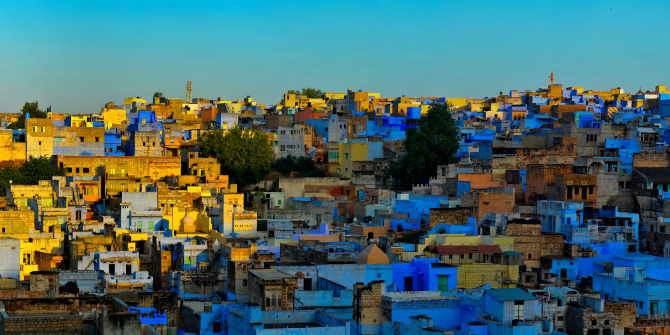Fuller and Narasimhan have produced an excellent book which will be highly useful to those who wish to learn more about Tamil Brahmans as a middle-class caste or to consider the intricacies of caste and class in South Asia more broadly. Students of urbanization, mobility, and modernity will also benefit from this work, writes Dannah Dennis.
 Tamil Brahmans: The Making of A Middle-Class Caste by C.J. Fuller and Haripriya Narasimhan. University of Chicago Press. 2014.
Tamil Brahmans: The Making of A Middle-Class Caste by C.J. Fuller and Haripriya Narasimhan. University of Chicago Press. 2014.
The complicated relationship between caste and class as structuring social principles is a crucial puzzle for scholars of South Asia. In this book, anthropologists CJ Fuller and Haripriya Narasimhan tackle the issue by tracing the rise of Tamil Brahmans from a primarily village-dwelling agrarian group in the late 19th century to a thoroughly urbanized, highly mobile, white-collar middle-class group in the early 21st century.
Drawing on existing historical and anthropological literatures as well as their own considerable ethnographic research, the authors argue that Tamil Brahmans have merged the categories of caste and class to become a middle-class caste, particularly through “their systematic tendency to equate traditional Brahman and modern middle-class values, as if they were one and the same” (p. 17). This is particularly evident in their discussions of education as a primary avenue for upward mobility. Tamil Brahmans have successfully used the historical association between Brahman caste status and high levels of education not only to bolster a strong group self-image, but also to position themselves as “ideal workers in the globalized ‘knowledge’ or ‘informational’ economy that has developed at the core of the neoliberal, capitalist world system” (p. 228).
A major theme of the book is that throughout the years, Tamil Brahmans have demonstrated a willingness to bend and flex the rules of caste purity and ritual observance in order to increase their material well-being and social prestige. For example, while the professions of medicine and engineering were originally considered to be unsuitable for Brahmans because of their respective associations with bodily impurity and artisanal labor, Tamil Brahmans overcame those caste scruples and eventually became highly represented in these fields. Because medicine and engineering, like law and higher-level administration, are “modern, English-language, credential-based professions that are well paid and prestigious,” they have “been deemed eminently suitable for Tamil Brahmans since the late nineteenth century” (p. 71). This balancing act, maintaining a sense of caste identity while pragmatically shifting caste practices to accommodate middle-class norms, calls to mind Mark Liechty’s Suitably Modern: Making Middle-Class Culture in a New Consumer Society, which explores a similar dynamic in Kathmandu in the 1990’s.
As one might expect in a study of caste, themes of kinship and gender are important areas of inquiry. The fourth chapter analyzes the changing roles of women, which are a crucial element of the creation of a modern caste identity. Practices such as child marriage and strict seclusion of women at home have given way to women’s participation alongside men in the white-collar workforce and a contemporary ideal of companionate marriage between partners who are roughly equal in terms of age, employment, and educational profiles. However, the authors are careful to point out that caste endogamy is still the norm and, moreover, is perceived as compatible with companionate marriage because it assures that the partners will share a common cultural background. Thus, “the contemporary marriage system plays a fundamental role in reproducing caste as well as class,” reinforcing the stability of Tamil Brahmans as a “caste-cum-class-unit” (p. 143).
Gender resurfaces as a consideration in chapter 5, which compares Tamil Brahman communities in Chennai, Bangalore, Mumbai, and the suburban United States. Pressure to confirm to certain standards of expected caste behavior, such as vegetarianism, tends to be the strongest in Chennai, which has the most concentrated population of Brahmans. These social standards are somewhat relaxed in the relatively cosmopolitan cities of Bangalore and Mumbai, while migrants in the US adjust themselves to different sets of expectations in order to maintain their model-minority status. Since women are more subject than men to informal means of social control such as gossip, many of the women in the study expressed a dislike of the social surveillance present in the Brahman neighborhoods of Chennai and a preference for the relatively greater personal independence that they experienced in more socially heterogeneous locales. The comparison of these sites of Tamil Brahman settlement could be an interesting book-length study in and of itself.
Chapter 6 deals with three significant forms of cultural capital which are linked to both class and caste identities: namely, religion, music, and dance. While the priesthood as a profession is relatively looked down upon by today’s Tamil Brahmans, some still draw on their caste legacy as the guardians of Sanskritic Hinduism as a source of pride and social power. A brief case study of a Sanskrit sloka-singing class provides a fascinating illustration of the political and cultural claims that surround the use of Sanskrit, which is “never a neutral act” (p. 196). As for the highly-valued art forms of Carnatic music and Bharatanatyam dance, the authors demonstrate how these were largely constructed during the 20th century as expressions of particularly Brahman ethical and aesthetic values. Mastery of these arts is seen as a mark of refinement and class, and the ability to sing or dance is a highly valued quality in a Tamil Brahman bride.
As a research team, Fuller and Narasimhan are well equipped to dig deep into their source material. The complementarity of their outsider-insider positions as a Western man and a Tamil Brahman woman allows them to access a wider range of interlocutors and viewpoints than either could do in a solo project, and their analysis is coherent and compelling. They are forthright about shortcomings which have limited their analysis, such as the general unavailability of reliable statistics about Tamil Brahmans and a relative lack of non-Brahman perspectives about Brahmans in their data. In my view, the latter could have been remedied by a more in-depth engagement with the non-Brahman movement of the early 1900’s and, as the researchers themselves suggest, by the addition of a Tamil non-Brahman member to their research team.
Despite these limitations, however, Fuller and Narasimhan have produced an excellent book which will be highly useful to those who wish to learn more about Tamil Brahmans as a middle-class caste or to consider the intricacies of caste and class in South Asia more broadly. Students of urbanization, mobility, and modernity will also benefit from this work.
Dannah Dennis is a PhD candidate in Anthropology at the University of Virginia. She currently lives in Kathmandu and conducts research on political transition, citizenship, secularism, and education. You can find her on Twitter @dannahdennis.








2 Comments